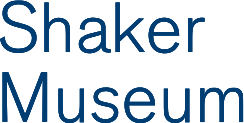Metronome
Mode-ometer or metronome made by Brother Isaac Newton Youngs, Church Family, Mount Lebanon, NY
Description
Metronome or mode-ometer made of pine wood, copper and steel fittings, and a cotton string weighted with a lead ball or bullet. Two-foot-long piece fastened at one end slides down length. Horn-shaped piece of tin on end. Notations in writing on the back. String, lead shot, and wood and tin-plate slide used to adjust the length of the string have been replaced.
Notes
The Shakers made monumental efforts to be "in union" with each other in all aspects of their lives, especially in their worship. To this end Shakers transcribed the words to thousands of hymns and songs and developed a unique system of notation using letters and special symbols to record the melodies. Manuscript and printed hymnals were sent from community to community, with the pitch identified by devices such as tuning forks or pitch pipes. Shakers struggled, however, to transfer information on the tempo at which songs were to be sung. This was of special concern with dance tunes.[1] Around 1841 Isaac N. Youngs (1793-1865), one of the strongest proponents of standardizing Shaker musical notation, built a device that he called a "mode-ometer" or "speediometer." It employed a pendulum consisting of a string of variable length weighted with a lead ball to set the proper tempo. In 1843 Youngs wrote and published a piece concerning the rules of music and the use of his device: "The learner should be provided with a speediometer [an instrument already well known] to vibrate or swing once in a second. A bullet, attached to a smooth string, 39 1/2 inches long, from the point of suspension, to the center of the ball, will very nearly vibrate seconds."[2] Youngs also provided a "Table of Modes" in which he named the modes adagio, largo, allegro, and presto, including the length at which the string should be set for each. This mode-ometer is certainly one made by Youngs. The writing used to identify the calibration of the different modes is in his distinctive hand. In addition, Youngs used the denominator "7" in time signatures representing pieces to be sung in 6/8 time, believing that there needed to be seven eighth notes per measure in this mode to fit the natural rhythm of the voice and body. This notation, rejected by other Shaker music theorists, is used in calibration of the mode-ometer.[3] The string, lead shot, and wood and tin-plate slide used to adjust the length of the string have been replaced. [1] Daniel W. Patterson, The Shaker Spiritual (Princeton, NJ: Princeton University Press, 1979), pp. 49-50. [2] Isaac Newton Youngs, A Short Abridgement Of The Rules of Music With Lessons For Exercise, and A few Observations; For new Beginners (New Lebanon, NY: United Society of Shakers, 1843), p. 15, 30-32. [3] Patterson, op. cit., pp. 25, 50.
New York Mount Lebanon Church Family













